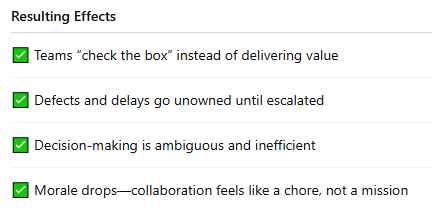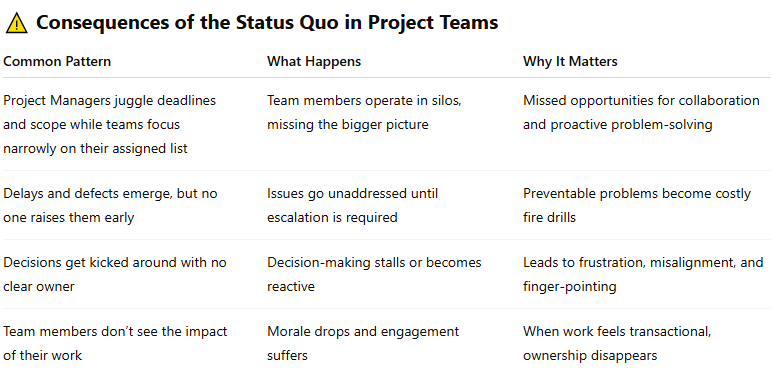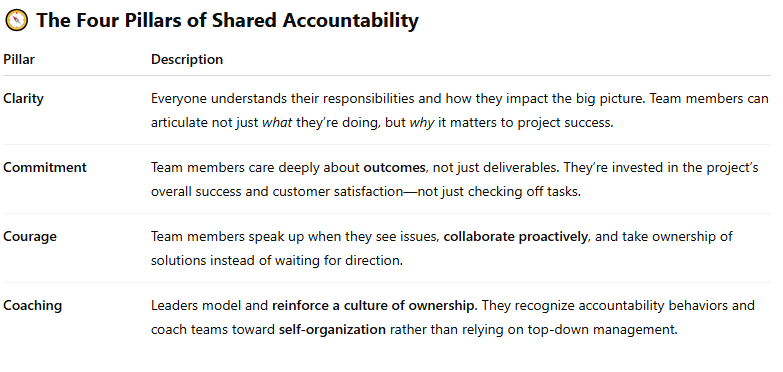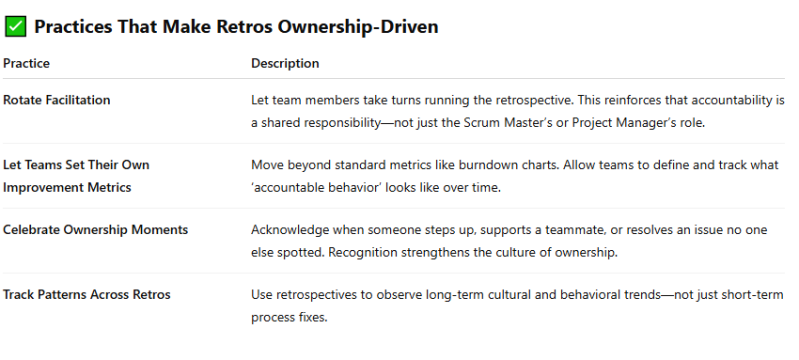In today's dynamic and fast-paced project environments, ticking off tasks on a checklist no longer guarantees successful outcomes. Teams that thrive don't just divide the work—they share the responsibility. That’s because project ownership is no longer the sole domain of the project manager. It’s a team sport. When team members feel personally responsible for project outcomes—not just their assigned tasks—everything changes. Engagement deepens. Communication improves. Problems get solved faster. And results become more meaningful.
So how do we move from individual accountability to a culture of shared ownership? Here are key takeaways from my recent talk on how to build and lead with this mindset.

🧩 Why Siloed Ownership Fails
Why is Shared Accountability so important? If you’ve ever been on a project where deliverables were met but value wasn’t delivered, you already know something was missing.
That missing piece is often accountability—real accountability, not just assigned responsibility.
Projects that rely on isolated task ownership often suffer from:
- Unresolved issues due to “not my job” thinking
- Confusion and delays when no one owns the decision-making
- Low morale from a disconnected team experience
- Mediocre results that check the box but don’t deliver real value
That missing piece is often accountability—real accountability, not just assigned responsibility.
Let’s dig into what happens when accountability stays in silos—or worse, only with the project manager.
- Task Focused Mindset
- Unowned Problems
- Decision Paralysis
- Declining Morale
These patterns show up all the time, even in mature organizations. They feel normal—but they quietly derail projects from within.


What Shared Accountability Looks like
Shared Accountability isn’t about assigning more work—it’s about aligning people around purpose, value, and ownership of outcomes.
In a culture of shared accountability, everyone—from developers and analysts to testers and sponsors—feels responsible for the success of the whole project, not just their part in it.
The four pillars of shared accountability are Clarity, Commitment, Courage, and Coaching.

🏁 Start Strong: Ownership Begins at Kickoff
One of the most overlooked opportunities to build shared accountability is the project kickoff. The way you start a project often defines how you’ll finish it.
If we treat kickoff like a logistics meeting—assigning tasks, timelines, and deliverables—we miss the chance to establish ownership behaviors early.
It’s our first real opportunity to:
- Set expectations around shared responsibility
- Clarify how decisions will be made
- Build trust and alignment between cross-functional partners
The tone for shared accountability is set on Day 1. Instead of focusing solely on scope and timelines, the kickoff should:
- Define success in terms of outcomes, not deliverables
- Set expectations for decision-making and communication
- Introduce ownership as a team value, not an individual trait
- Anticipate obstacles—and agree to solve them together

When you model transparency, trust, and shared ownership at the kickoff, you normalize that behavior for the rest of the project.
Don’t wait until delivery problems emerge to introduce these ideas—make them part of the DNA from the very beginning.
📜 Create a Collaborative Team Charter
A lot of teams treat the team charter as a checkbox—one more artifact to be archived. But a truly effective charter is not just a document—it’s a shared agreement created by the team, for the team. It becomes your north star—your internal contract for how you’ll work, collaborate, and solve problems together.
The key to success is co-creation. Don’t hand your team a pre-written charter.
A team charter isn’t just an administrative document. When built together, it becomes a living agreement that:
- Clarifies shared goals and success metrics
- Defines roles and decision boundaries
- Establishes norms and working agreements
- Identifies risks and co-creates mitigation strategies

This process fosters psychological ownership—people commit to what they help build. When people help define the rules, they’re more likely to follow them—and hold others accountable to them. Team charters reduce miscommunication, finger-pointing, and hidden assumptions. The team charter isn’t set in stone—it should evolve as the project evolves
Strategic Benefits
Team charters reduce miscommunication, finger-pointing, and hidden assumptions.
They help onboard new team members quickly and serve as a reference point when accountability starts to slip.
Make It Living, Not Static
The team charter isn’t set in stone—it should evolve as the project evolves.
Revisit it at retrospectives, major milestones, or anytime dynamics shift.
👉 Recommend: Pin your charter in your team’s shared workspace—Confluence, SharePoint, or your Agile board.
🧭 Clarifying Roles with Purpose
One of the biggest killers of shared accountability is role ambiguity.
Whether you’re in Agile or Waterfall, role ambiguity kills accountability. Use tools like a RACI matrix or visual role maps to ensure everyone knows:
- What they own
- Who they depend on
- What they can decide without escalation
When people don’t know what they own—or think someone else owns it—you get:
- Duplicated work
- Missed handoffs
- Decision bottlenecks
- And ultimately, project delays or blame cycles
Have you ever been on a project where three people thought someone else was responsible—and no one followed through? Roles are more than job descriptions. In high-performing teams, roles reflect who is accountable for what outcomes, not just task lists. It’s important to define not only who does what, but how their work connects to the greater whole.
Ownership ≠ Job Title
Roles are more than job descriptions. In high-performing teams, roles reflect who is accountable for what outcomes, not just task lists.
It’s important to define not only who does what, but how their work connects to the greater whole.
Visual Role Tools
Visual Tools bring role clarity to life. reduce guesswork and clarify boundaries.

When team members know what they’re responsible for and why it matters, they:
- Prioritize better
- Make smarter tradeoffs
- Collaborate with greater confidence
- They hold each other accountable—because they’re not afraid of stepping on toes.
Roles should evolve as the project evolves. If scope or strategy changes, revisit the RACI or decision matrix and make sure it still reflects reality.
👉 Check in on role clarity during retrospectives or milestone reviews—it should be a living part of your team charter
🧭 From Tasks to Outcomes: Shift the Mindset
One of the most important mindset shifts we can make as project leaders is guiding our teams from a task focus to an outcome focus.
Why? Because completing tasks doesn't guarantee success—delivering the intended result does.
A task is a means to an end. But too often, that end gets lost in the daily grind. A task says, “I did my part.” An outcome says, “We succeeded together.”
Ask questions that reframe work:
- “What problem are we solving?”
- “Who benefits from this?”
- “How do we know we added value?”
This mindset shift inspires innovation, alignment, and proactive problem-solving. It’s not about getting things done. It’s about getting the right things done—and knowing why they matter.
Ask your team: ‘How will we know this work added value?’ If no one can answer, the task needs reframing.
As a project leader, you can model this by how you speak. Instead of saying, 'Let’s make sure we finish the UAT scripts,' say, 'Let’s make sure our scripts help uncover issues before launch, so we don’t surprise users later.’ When you lead with the why, your team will start doing it too.
This shift builds stronger engagement, innovation, and accountability.
When people understand the intended result, they:
- Make better decisions in the moment
- Collaborate more purposefully
- Raise concerns proactively
👉 Shared accountability thrives in outcome-driven cultures—because people are aligned on impact, not just effort.

💬 Coach, Don’t Command
Project leaders can reinforce and sustain shared accountability through coaching—especially in the day-to-day rhythms of the project. Once your team starts to understand the difference between tasks and outcomes, your job shifts from managing timelines to coaching accountability. That means helping the team internalize ownership—not just assigning it.
1. Reinforce the Role of Project Leader as a Coach
Think of yourself less as a traffic cop and more as a mindset coach. You’re there to guide—not micromanage.
Leaders build accountability by modeling it. That means:
- Admitting mistakes
- Asking questions instead of giving orders
- Celebrating early warnings, not just heroics
- Being transparent in decisions
Project ownership grows when leadership makes space for it.
2. Embed it into Existing Ceremonies
You don’t need to create new meetings—use the ones you already have more intentionally (Daily Standups, Sprint Reviews/Demos, and Retrospectives).

3. Use Key Coaching Tactics

4. Normalize the Discomfort of Growth
Coaching accountability isn’t always easy—it means helping team members move beyond their comfort zones.
That could mean taking initiative, raising a concern, or admitting a mistake. Make it safe to do those things.
🔄 Use Retrospectives to Reinforce Accountability
Retrospectives are often thought of as purely Agile tools for improving processes. But in reality, they’re so much more than that—they're accountability checkpoints that help teams look inward at how they’re owning outcomes, not just tasks.
👉 If you're only using retros to ask ‘what went wrong?’ you're missing the bigger picture. Use them to ask, ‘who owned this—and how did we show up?’
Accountability-Focused Retrospectives
Retrospectives aren't just for process tweaks. They're mirrors for accountability and ownership. Ask:
- Where did we lean in—or defer—this sprint?
- What supported or hindered our commitment?
- How did our behaviors influence the outcome?
- Where did we take ownership this sprint or phase?
- Where did we defer or wait when we could have leaned in?
- What helped or hurt our shared commitment?
- How did our individual actions support or block team results?
- What assumptions stopped us from stepping up?
👉 Tip: Use these questions in retros monthly or quarterly, even if your team runs shorter delivery cycles.
Ownership-Focused Retrospectives
A good retrospective doesn’t just identify problems—it helps the team reflect on their behavior, mindset, and impact.
It’s where shared accountability either gets strengthened—or eroded.
By owning the review process, teams start to own the results.

Are the same issues showing up? Are people owning more over time? This data is powerful for team health.
Apply Outside of Agile Environments
Even if you're in a Waterfall or hybrid setting, use project post-mortems or milestone reviews as accountability retrospectives.
Ask: 'Did we act as a cohesive team or a collection of roles?'
Retrospectives (or lessons learned) are more than a feedback loop—they’re an accountability pulse check. Make them a space for honest reflection:
- “Where did we take ownership this sprint?”
- “Where did we defer when we could have leaned in?”
- “What helped or hurt our team-wide commitment?”
Encourage team-led retrospectives, not just facilitator-run ones. When teams own the review process, they start to own the results too.
Accountability Beyond Agile Environments
At this point, you might be thinking, 'This all sounds great—but we’re not Agile.' Or, 'We use a hybrid framework—will this still apply?’ The answer is absolutely yes. Shared accountability isn’t about methodology—it’s about team behavior. These techniques aren’t exclusive to Agile environments. Whether you're in a traditional PMO or a SAFe train, shared accountability applies:
- In traditional settings, embed ownership in gate reviews and stakeholder updates
- In hybrid teams, use sprints for delivery but team charters for cohesion
- In Agile, make value delivery—not just velocity—the goal
Let me show you how these principles flex to fit any delivery model.

Across all three environments, the tools may differ—but the principles remain the same:
- Clarity of roles
- Commitment to outcomes
- Coaching for mindset
- Courage to speak up
👉 Accountability isn’t tied to your framework—it’s tied to your culture.
📏 Measuring What Matters
Shared accountability isn’t just a feel-good philosophy or soft skill—it drives real impact and is a measurable performance driver:
How do we know if shared accountability is actually working? We can’t just assume our culture is improving—we need to observe, measure, and adjust based on what we learn.
Traditional project metrics focus on scope, time, and cost—but shared accountability shows up in more subtle, yet powerful, ways.
Here are a few quantitative indicators that show your team is moving from task-based behavior to shared ownership.
- ⏱ 24% faster issue resolution
- 🔍 3x more proactive problem identification
- 😊 85% higher stakeholder satisfaction
- 💡 40% increase in team engagement
Look for signs like increased initiative, richer discussions, and stronger collaboration.
Beyond metrics, look for qualitative behavioral indicators that show a shift is happening:
- More volunteering for high-visibility work
- Cross-functional collaboration without being asked
- Stronger retrospectives with open, honest feedback
- Teammates checking in on each other’s blockers
👉 When ownership grows, you’ll feel it in the team energy—before it shows up in the data.
Of course, measurement is just one piece of the puzzle. To sustain shared accountability, you’ll also need to build the skills, address resistance, and lead with intention.
🛠 Overcoming Resistance
Not everyone will jump on board right away. Address common objections:
- “I’m too busy” → It’s not extra work—it’s better teamwork.
- “I don’t have authority” → Empower with clear frameworks.
- “That’s the PM’s job” → Evolve, don’t abandon, existing processes.
Ownership is a culture shift—guide it with empathy and clarity.
1. Normalize the Resistance
It’s important to recognize not everyone will jump on board with shared accountability from the start—and that’s okay.
Resistance is a normal part of culture change. The key is to understand where it’s coming from and respond in a way that builds trust and clarity.
👉 When someone resists, they’re usually not being difficult—they’re being human.
2. Common Resistance Personas

3. Offer a General Strategy
Across all these personas, the key is to:
- Listen first
- Reframe their concerns
- Offer support through coaching and structure
4. Leadership Reminder
People don’t resist accountability—they resist uncertainty, overload, or exclusion.
Your role as a leader is to remove friction, model vulnerability, and help people see how shared ownership makes their work easier—not harder.
👉 When people feel seen, supported, and safe—they’ll lean into accountability.
Cultivating Accountability Skills
Shared accountability isn't just a mindset—it's a skill set that can (and should) be developed across the team.
Accountability Is Learnable
One of the biggest myths about accountability is that it’s either something you have—or you don’t.
But just like communication, conflict resolution, or leadership—accountability is a skill. And like any skill, it can be cultivated with practice, feedback, and coaching.
Skill-Building Matters
We can talk about shared ownership all day, but unless we give people the tools to practice it, they’ll default to their comfort zones.
Let’s break down four core skill areas that support a culture of accountability.

Don’t expect mastery overnight. Start with small, low-risk scenarios where people can flex these muscles before it’s mission-critical.
Your role is to create the psychological safety where learning is possible.
Leadership Behaviors That Foster Accountability
Leaders set the tone for shared accountability not by what they say, but by what they model.
1. Leadership Drives Culture
You can have the best processes, charters, and metrics in place—but if leadership behavior doesn’t reinforce accountability, the culture won’t shift.
As leaders, we are constantly sending signals—about what matters, what’s rewarded, and what’s safe to say or do.
👉Your actions are always louder than your agenda.
2. Recognize Behaviors that Foster and Undermine Accountability
The tables below highlight key leadership behaviors that either foster or undermine a culture of shared accountability within project teams.


3. Reinforce the Leadership Message
If you want a culture of ownership, be the first to demonstrate it.
Start with how you show up in meetings, how you respond to bad news, and how you support team-led problem solving.
👉 People remember how you behave when things go wrong more than when they go right.
4. Invite Reflection
As you think about your own leadership, ask:
- What signals am I sending about accountability?
- Where might I unintentionally be blocking it?
- What’s one behavior I can change this week to create more ownership in my team?
🔁 What You Can Do Today
What’s one thing you can do tomorrow to begin building a culture of shared accountability?
You don’t need a full framework or budget approval to start—you just need intentional conversations and small shifts in behavior.
Action 1. Ask the ownership question: “How does this connect to our outcome?”
- Who owns the outcome of this deliverable?
- Start inserting this question into your team meetings, standups, and planning sessions.
- It invites reflection, alignment, and clarity—because sometimes what’s missing is simply asking the right question.
👉 Tip: Ask this out loud the next time something gets stuck—it often reveals gaps or opportunities for collaboration.
Action 2. Add a mini-charter to your next project kickoff
Even if you don’t have time for a full-blown team charter, carve out 15–20 minutes during your next kickoff or sprint planning to align on:
- Shared goals
- Team expectations
- Decision boundaries
This can prevent weeks of misalignment later.
Action 3. Use one outcome-framing question per day
- What problem are we solving?
- How will we know we’ve delivered value?
- What impact will this have on the customer?
- Pick one and use it in your next standup or status meeting. See how it shifts the conversation.
Action 4. Recognize ownership behavior in your team openly and often
Look for—and call out—examples of proactive collaboration, cross-functional support, or early risk flagging.
You get more of what you praise. Highlight the behavior you want the team to replicate.
👉 Celebrating ownership moments is one of the fastest ways to normalize them.
Action 5. Reinforce the Mindset
Small actions, taken consistently, create cultural change.
Every great culture of shared accountability started with a few people deciding to think and behave differently.
Commitment
So, as you leave today, I invite you to choose just one action from this list—and try it this week.
Whether you're a Scrum Master, project manager, team lead, or individual contributor—you can influence how your team shows up.
🚀 Final Thought
When we stop asking “Did we complete the project?” and start asking “Did we own the outcome together?”—we transform project delivery from a checklist into a shared victory.
Where do you see an opportunity to strengthen accountability in your own team?
It’s time to stop managing projects like a relay race and start treating them like a team sport.
#ManagingProjectsTheAgileWay #SharedAccountability #ProjectLeadership #AgileMindset #TeamEngagement #OutcomeDriven #ProjectOwnership #Retrospectives #TeamCharter #LeadershipInAction #ProjectSuccess
Download Document, PDF, or Presentation
Author: Kimberly Wiethoff